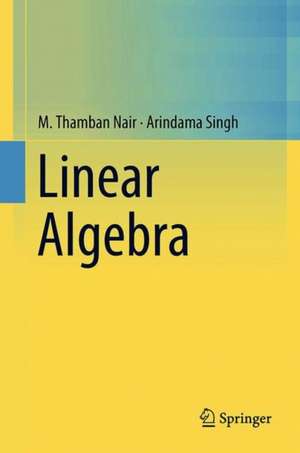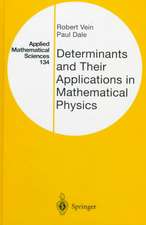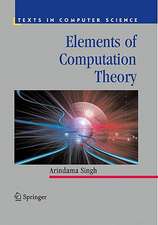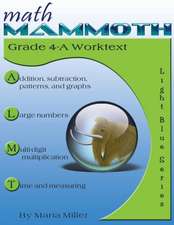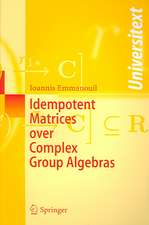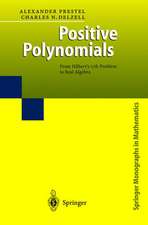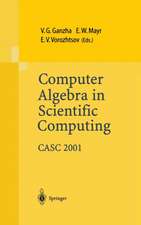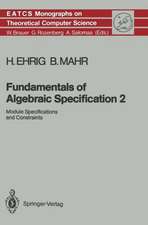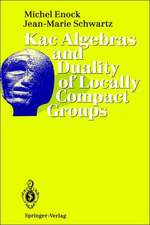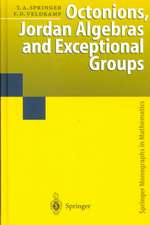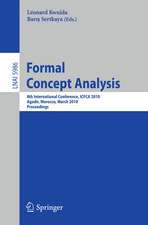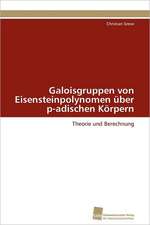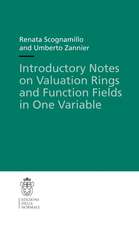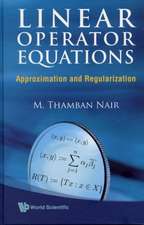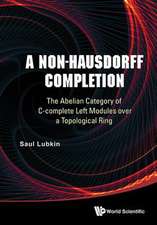Linear Algebra
Autor M. Thamban Nair, Arindama Singhen Limba Engleză Hardback – 2 aug 2018
Divided into seven chapters, it discusses vector spaces, linear transformations, best approximation in inner product spaces, eigenvalues and eigenvectors, block diagonalisation, triangularisation, Jordan form, singular value decomposition, polar decomposition, and many more topics that are relevant to applications. The topics chosen have become well-established over the years and are still very much in use. The approach is both geometric and algebraic. It avoids distraction from the main theme by deferring the exercises to theend of each section. These exercises aim at reinforcing the learned concepts rather than as exposing readers to the tricks involved in the computation. Problems included at the end of each chapter are relatively advanced and require a deep understanding and assimilation of the topics.
| Toate formatele și edițiile | Preț | Express |
|---|---|---|
| Paperback (1) | 458.01 lei 6-8 săpt. | |
| Springer Nature Singapore – feb 2019 | 458.01 lei 6-8 săpt. | |
| Hardback (1) | 465.32 lei 6-8 săpt. | |
| Springer Nature Singapore – 2 aug 2018 | 465.32 lei 6-8 săpt. |
Preț: 465.32 lei
Nou
Puncte Express: 698
Preț estimativ în valută:
89.04€ • 91.86$ • 74.30£
89.04€ • 91.86$ • 74.30£
Carte tipărită la comandă
Livrare economică 26 martie-09 aprilie
Preluare comenzi: 021 569.72.76
Specificații
ISBN-13: 9789811309250
ISBN-10: 9811309256
Pagini: 345
Ilustrații: XI, 341 p. 2 illus.
Dimensiuni: 155 x 235 x 26 mm
Greutate: 0.67 kg
Ediția:1st ed. 2018
Editura: Springer Nature Singapore
Colecția Springer
Locul publicării:Singapore, Singapore
ISBN-10: 9811309256
Pagini: 345
Ilustrații: XI, 341 p. 2 illus.
Dimensiuni: 155 x 235 x 26 mm
Greutate: 0.67 kg
Ediția:1st ed. 2018
Editura: Springer Nature Singapore
Colecția Springer
Locul publicării:Singapore, Singapore
Cuprins
Chapter 1. Vector Spaces.- Chapter 2. Linear Transformations.- Chapter 3. Elementary Operations.- Chapter 4. Inner Product Spaces.- Chapter 5. Eigenvalues and Eigenvectors.- Chapter 6. Block Diagonal Representation.- Chapter 7. Spectral Decomposition.
Recenzii
“This textbook is suitable for a course on linear algebra for students of mathematics, sciences and engineering. … the material of the book is mostly suitable for a two-semester course for student of mathematics and it is also a useful introduction to functional analysis.” (Michal Zajac, zbMath 1414.15001, 2019)
“It is a very well written book. It is clear that Nair and Singh put a lot of work into the text to make the concepts elaborate and lively at the same time. This book can build the confidence of a student majoring in mathematics, science, or engineering by building their critical thinking skills and problem-solving skills – not to mention practice with writing proofs.” (Peter Olszewski, MAA Reviews, March, 8, 2019)
“It is a very well written book. It is clear that Nair and Singh put a lot of work into the text to make the concepts elaborate and lively at the same time. This book can build the confidence of a student majoring in mathematics, science, or engineering by building their critical thinking skills and problem-solving skills – not to mention practice with writing proofs.” (Peter Olszewski, MAA Reviews, March, 8, 2019)
Notă biografică
M. Thamban Nair is a professor of mathematics at the Indian Institute of Technology Madras, Chennai, India. He completed his Ph.D. at the Indian Institute of Technology Bombay, Mumbai, India, in 1986. His research interests include functional analysis and operator theory, specifically spectral approximation, the approximate solution of integral and operator equations, regularization of inverse and ill-posed problems. He has published three books, including a textbook, Functional Analysis: A First Course (PHI Learning), and a text-cum-monograph, Linear Operator Equations: Approximation and Regularization (World Scientific), and over 90 papers in reputed journals and refereed conference proceedings. He has guided six Ph.D. students and is an editorial board member of the Journal of Analysis and Number Theory, and Journal of Mathematical Analysis. He is a life member of academic bodies such as Indian Mathematical Society and Ramanujan Mathematical Society.
Arindama Singh is a professor of mathematics at the Indian Institute of Technology Madras, Chennai, India. He completed his Ph.D. at the Indian Institute of Technology Kanpur, India, in 1990. His research interests include knowledge compilation, singular perturbation, mathematical learning theory, image processing, and numerical linear algebra. He has published five books, including Elements of Computation Theory (Springer), and over 47 papers in reputed journals and refereed conference proceedings. He has guided five Ph.D. students and is a life member of many academic bodies, including Indian Society for Industrial and Applied Mathematics, Indian Society of Technical Education, Ramanujan Mathematical Society, Indian Mathematical Society, and The Association of Mathematics Teachers of India
Arindama Singh is a professor of mathematics at the Indian Institute of Technology Madras, Chennai, India. He completed his Ph.D. at the Indian Institute of Technology Kanpur, India, in 1990. His research interests include knowledge compilation, singular perturbation, mathematical learning theory, image processing, and numerical linear algebra. He has published five books, including Elements of Computation Theory (Springer), and over 47 papers in reputed journals and refereed conference proceedings. He has guided five Ph.D. students and is a life member of many academic bodies, including Indian Society for Industrial and Applied Mathematics, Indian Society of Technical Education, Ramanujan Mathematical Society, Indian Mathematical Society, and The Association of Mathematics Teachers of India
Textul de pe ultima copertă
This book introduces the fundamental concepts, techniques and results of linear algebra that form the basis of analysis, applied mathematics and algebra. Intended as a text for undergraduate students of mathematics, science and engineering with a knowledge of set theory, it discusses the concepts that are constantly used by scientists and engineers. It also lays the foundation for the language and framework for modern analysis and its applications.
Divided into seven chapters, it discusses vector spaces, linear transformations, best approximation in inner product spaces, eigenvalues and eigenvectors, block diagonalisation, triangularisation, Jordan form, singular value decomposition, polar decomposition, and many more topics that are relevant to applications. The topics chosen have become well-established over the years and are still very much in use. The approach is both geometric and algebraic. It avoids distraction from the main theme by deferring the exercises to theend of each section. These exercises aim at reinforcing the learned concepts rather than as exposing readers to the tricks involved in the computation. Problems included at the end of each chapter are relatively advanced and require a deep understanding and assimilation of the topics.
Divided into seven chapters, it discusses vector spaces, linear transformations, best approximation in inner product spaces, eigenvalues and eigenvectors, block diagonalisation, triangularisation, Jordan form, singular value decomposition, polar decomposition, and many more topics that are relevant to applications. The topics chosen have become well-established over the years and are still very much in use. The approach is both geometric and algebraic. It avoids distraction from the main theme by deferring the exercises to theend of each section. These exercises aim at reinforcing the learned concepts rather than as exposing readers to the tricks involved in the computation. Problems included at the end of each chapter are relatively advanced and require a deep understanding and assimilation of the topics.
Caracteristici
Presents Gaussian elimination and the Gauss–Jordan elimination process Elaborates on the use of projection operators due to their importance in applications Discusses solvability of linear equations as an application of results on linear transformations rather than using elementary operations Includes extensive definitions, proofs, exercises, problems, and other pedagogical aids Highlights intuitive aspects and their implementation with rigorous formalization Is useful to undergraduate mathematics and engineering students
